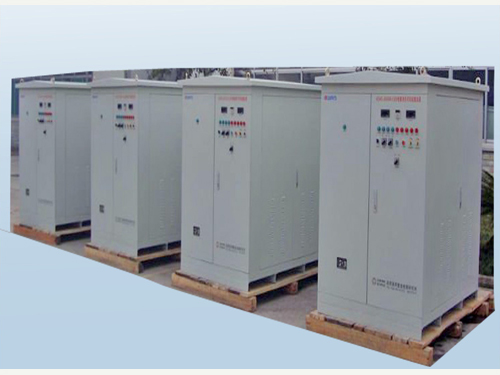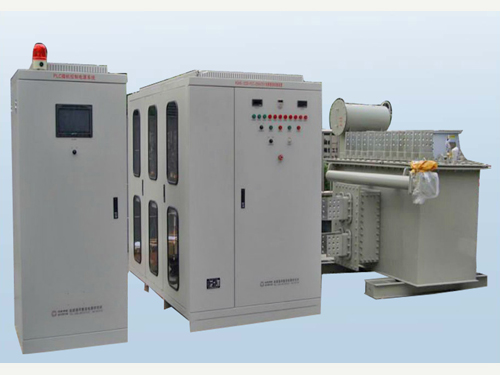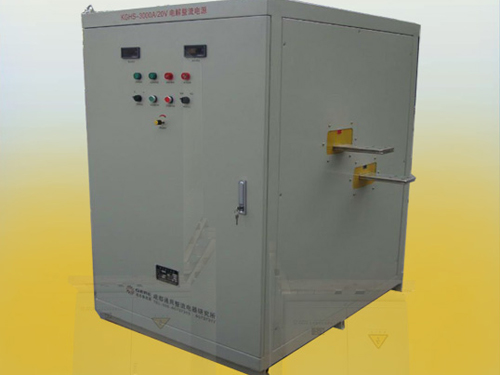Home » New Products » Custom Rectifiers
Product List
Rectifier
- KGHS Series Electrolytic Cleaning Rectifier Device
 KGHS series electrolytic cleaning rectifiers adopt thyristor rectification technology. It is a special thyristor rectifier used for electrochemical...
KGHS series electrolytic cleaning rectifiers adopt thyristor rectification technology. It is a special thyristor rectifier used for electrochemical...
- SCR Electrolytic Rectifier
 SCR electrolytic rectifier adopts SCR rectification technology. As a special electrolysis rectifier, this product is mainly used in electrochemistry, including...
SCR electrolytic rectifier adopts SCR rectification technology. As a special electrolysis rectifier, this product is mainly used in electrochemistry, including...
- KGHS-6DD (12DD)-PLC KGHS-6DD (12DD)-PLC Series SCR Electrolytic Rectifier
 kGHS series SCR electrolytic rectifiers adopt thyristor rectification technology. As a dedicated thyristor rectifier, it is mainly used for ...
kGHS series SCR electrolytic rectifiers adopt thyristor rectification technology. As a dedicated thyristor rectifier, it is mainly used for ...
- Inverter Soft Switch Electrolytic Rectifier
 This electrolytic rectifier adopts IGBT high frequency inverting soft switch rectifier technology. It is mainly used as all kinds of metal and nonmetal surface ...
This electrolytic rectifier adopts IGBT high frequency inverting soft switch rectifier technology. It is mainly used as all kinds of metal and nonmetal surface ...
- Silicon Controlled Electroplating Rectifier
 This electroplating rectifier adopts 6 pulse or 12 pulse SCR rectifier. The KGDF series electroplating rectifier is mainly used as all kinds of metal ...
This electroplating rectifier adopts 6 pulse or 12 pulse SCR rectifier. The KGDF series electroplating rectifier is mainly used as all kinds of metal ...
- KGDF/KGDF(S)/KGSF21-150A-230V Silicon Controlled Electroplating Rectifier
 KGDF series silicon controlled electroplating rectifiers adopt 6-pulse or 12-pulse thyristor rectifier. These silicon controlled rectifier are mainly ...
KGDF series silicon controlled electroplating rectifiers adopt 6-pulse or 12-pulse thyristor rectifier. These silicon controlled rectifier are mainly ...
Custom Rectifiers
We custom design and manufacture AC and DC power supplies. Our mid to large scale power supplies sytems have been widely used in aviation industry, wastewater treatment, plating and anodizing shops, as well as corrosion managment. Power supplies we make including frequency converters, aviation power supplies, cathodic protection power supplies, electrocoagulation power supplies, plating and anodizing rectifiers, heating power supplies for furnace, etc.Custom and Standard Rectifier Solutions
SCR/Large Thyristor/Chopper/SMPS Rectifiers
Since our founding in 1994, GERE has pushed the boundaries of what is possible in the development of custom and standard rectifier solutions. From SCR to IGBT to switchmode air and water-cooled rectifiers, GERE has supplied the automotive, aerospace, mining, water treatment, steel manufacturing, and finishing industries among others, with the most reliable custom and standard rectifiers solutions available.
What does Rectifier mean?
A rectifier is an electrical device composed of one or more diodes that converts alternating current (AC) to direct current (DC). A diode is like a one-way valve that allows an electrical current to flow in only one direction. This process is called rectification.
A rectifier can take the shape of several different physical forms such as solid-state diodes, vacuum tube diodes, mercury arc valves, silicon-controlled rectifiers and various other silicon-based semiconductor switches.
Rectifiers are used in various devices, including:
DC power supplies
Radio signals or detectors
A source of power instead of generating current
High-voltage direct current power transmission systems
Several household appliances use power rectifiers to create power, like notebooks or laptops, video game systems and televisions.
A rectifier is an electrical device that converts AC to DC. AC regularly reverses direction, while DC flows in one direction only.
Rectification produces a type of DC that encompasses active voltages and currents, which are then adjusted into a type of constant voltage DC, although this varies depending on the current's end use. The current is allowed to flow uninterrupted in one direction, and no current is allowed to flow in the opposite direction.
Almost all rectifiers contain more than one diode in particular arrangements. A rectifier also has different waveforms, such as:
Half Wave: Either the positive or negative wave is passed through and the other wave is blocked. It is not efficient because only half of the input wave form reaches the output.
Full Wave: Reverses the negative part of the AC wave form and combines it with the positive
Single-Phase AC: Two diodes can form a full-wave rectifier if the transformer is center-tapped. Four diodes arranged in a bridge are needed if there is no center-tap.
Three-Phase AC: Generally uses three pairs of diodes
One of the key problems with rectifiers is that AC power has peaks and lows, which may not produce a constant DC voltage. Usually a smoothing circuit or filter needs to be coupled with the power rectifier to produce a smooth DC current.
Application
Rectifiers have many uses, but are often found serving as components of DC power supplies and high-voltage direct current power transmission systems. Rectification may serve in roles other than to generate direct current for use as a source of power. As noted, detectors of radio signals serve as rectifiers. In gas heating systems flame rectification is used to detect presence of a flame.
Keywords:
100V 50A Electrophoresis Power Supply Unit High Frenquency Switching Rectifier


